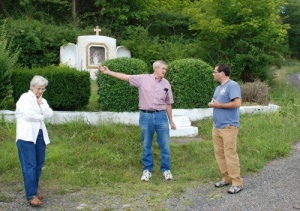(Matthew Streib is traveling across the country on his bicycle exploring religious sites that are inspiring and uniquely American. You can read more about his travels at http://www.americanpilgrimage.com.)
BYRNESVILLE, Pa. – The term “ghost town” generally conjures up images of tumbleweeds and abandoned saloons, not picturesque green hillsides in central Pennsylvania. But other than ominous clouds of steam and carbon monoxide, nothing is left of the tiny town of Byrnesville, except the Virgin Mary.
Byrnesville was demolished by the government in 1990s due to the dangerous conditions caused by an underground coal mine fire that started in nearby Centralia in 1962. Once a town of 28 families, now there is nothing but empty streets, a fractured highway, and vacant lots. The only people who come here are tourists to see the destruction and Mike and Jim Reilley, devoted sons who keep up the town’s shrine to Mary, the last standing structure.
“I don’t really go to church anymore,” says Mike, who trims the shrubs, cleans the stone, and replaces the statue when vandals steal it. A Catholic, he also prays to the Virgin Mary, who has been said to work miracles for inhabitants who pilgrimage from neighboring towns. “In a way, this has become my expression of faith,” he says.
Mike lived in Byrnesville for almost 50 years before he evacuated due to loss of electricity, water, and the danger of carbon monoxide seeping in through the basement. When he was 15 (he’s now 72), his father dreamt up the idea of the shrine, and the whole family built it out of concrete and old bathtubs. He misses the town deeply, and maintains a website to remind people of the town’s history.
“There were blueberries all over the place, blackberries, huckleberries, and we’d go out in the woods all the time,” he says. “The coal mines were actually a nuisance-they’d be digging for coal, with big shovels, dirt, and lots of noise. But it was also entertainment. We’d be sitting there, watching the trucks go by, with all the lights on at night.”
The coal fires under the ground still burn, and have enough fuel to last for another 250 years. The town is uninhabitable, and will remain so indefinitely. But for the two brothers who so loved the town, its memory will never die.





